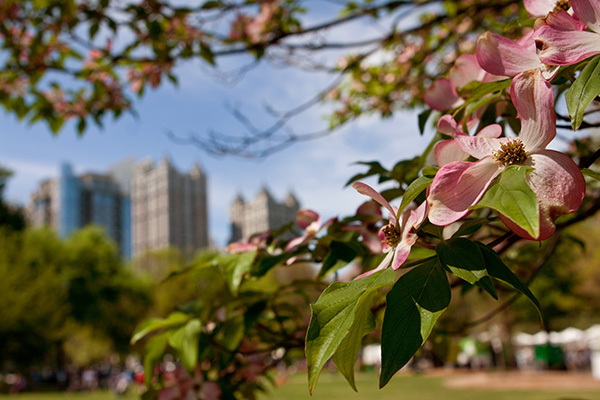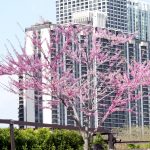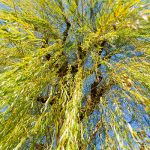
Learn more about Dogwood trees native to Illinois and how to plant one and care for one in your own yard
To continue our ongoing series highlighting the native trees in the Chicago region, we will cover the dogwood tree. Dogwood trees are found throughout the Chicago area because they are a very popular ornamental tree. Most species of dogwood have stunning flowers that bloom early in the spring and in the fall, the green leaves turn to brilliant purples and reds. Dogwoods are also small to medium sized trees and do not need a lot of space to grow. The fall colors and flowers of the dogwood, along with its ability to grow in smaller spaces, is why homeowners and commercial property owners commonly include dogwood trees in their yards or landscapes.
While there are many different species of dogwood trees, there are two that are native to Illinois: flowering dogwoods and pagoda dogwoods. This guide contains general information about both types of native dogwood trees, including common characteristics, proper care tips, and biggest threats such as insects and disease. At Hendricksen Tree Care, we understand how an in-bloom dogwood tree can add much color and beauty to your yard or landscape. Our arborists can provide professional tree care for native dogwood trees as well as prevent and treat problems caused by disease or insects.
Main Characteristics of Dogwood Trees

Dogwood trees are both native to Chicagoland and commonly planted in parks and used for landscaping homes throughout the suburbs of Illinois
Dogwood trees are small to medium sized deciduous trees that are known for their showy flowers. Pagoda dogwoods (Cornus alternifolia) are found in the northeast United States and southeast Canada from Newfoundland to Minnesota, and flowering dogwoods (Cornus florida) are found in eastern North America from Maine down to northern Mexico.
Both of these species of dogwood share many common characteristics, including an average height of 15-30 feet, showy flowers that bloom early in the spring, red and purple fall foliage, and drupe fruits that attract birds. Flowering dogwoods and pagoda dogwoods also both grow best in acidic soil which you should keep in mind when planting a new dogwood. With the right care and conditions, a dogwood tree can live up to 80 years.
The following are the specific characteristics of each type of native dogwood:
Flowering Dogwoods
- Height: Flowering dogwoods usually grow between 20 and 40 feet in height and can be 20 feet wide when fully mature.
- Leaves: The leaves of a flowering dogwood are round in shape with a pointed tip and they grow opposite. They are green in season but turn reddish brown in the fall.
- Flowers: Flowering dogwoods have showy flowers that bloom in the spring. The flowers typically have 4 oval-shaped bracts (like a pedal) that are typically red, pink, or white in color. A greenish flower cluster is in the center of the flower where the bracts meet.
- Fruit: Flowering dogwoods produce clusters of drupes which are berry like fruits with a seed in the middle. The flesh of the drupes ranges in color from red to orange.
- Bark: The bark of a flowering dogwood is grayish brown in color with darker colored inner bark. The texture of the bark appears blocky.
Pagoda Dogwoods
- Height: Pagoda dogwoods generally grow to be between 15 and 25 feet tall, and on rare occasions can reach up to 30 feet. Their width when mature ranges from 20 to 30 feet.
- Leaves: The leaves of a pagoda dogwood are oval shaped and grow alternate on the branch. They are medium green in color in season and become red and purple in the fall.
- Flowers: The flowers of a pagoda dogwood are small and white, and they grow in small clusters at the ends of the branches.
- Fruit: Pagoda dogwoods also produce small drupes, but they are bluish-black in color.
- Bark: The bark of a pagoda dogwood is reddish brown in color with shallow, vertical ridges.
Native Illinois Dogwood Trees
As we have discussed, the flowering dogwood and pagoda dogwood are the two main types of dogwood trees native to the Chicago region. There are several varieties of each of these main types that can be found throughout the area.
Types of Flowering Dogwoods in Illinois
- Cherokee Chief Flowering Dogwood: The Cherokee Chief dogwood is a smaller tree that grows to about 20 feet in height. It is known for its bright red flowers.
- Cloud 9 Flowering Dogwood: This dogwood tree can grow between 15 and 30 feet tall and it has showy white flowers.
- Dwarf Red Flowering Dogwood: Dwarf red dogwoods are small trees that grow no more than 5 to 6 feet tall. Its flowers are generally pink to red in color.
- Stellar Pink Flowering Dogwood: These dogwoods grow to about 20 feet in height and they are known for their pink flowers.
- Sweetwater Red Flowering Dogwood: Sweetwater red dogwoods grow to about 20 feet in height and they have reddish foliage and flowers that turn burgundy on the fall.
Types of Pagoda Dogwoods in Illinois
- Gold Bullion Pagoda Dogwood: These smaller dogwoods grow to be about 8 to 10 feet tall and they have yellow foliage.
- Golden Shadows Pagoda Dogwood: These plants are also relatively small with yellowish white leaves.
Threats to Dogwood Trees – Diseases and Pests
Both flowering dogwoods and pagoda dogwoods are vulnerable to a number of diseases and pests that can damage and even kill the tree. Certain conditions such as drought stress, poorly drained soil, and excessive wind can make dogwoods more susceptible to disease and pest infestations. The following are the most common threats to native dogwood trees in Illinois:
- Anthracnose: This is a serious disease that can affect all types of dogwoods. A fungus known as Discula destructiva causes cankers which are growths of dead tissue that will eventually grow large enough to cause damage to the tree. This disease can be lethal for dogwoods, so it is important to recognize the signs early for treatment.
- Golden stem canker: This is another kind of canker disease that is only known to affect pagoda dogwoods. Golden canker affects the branches of the tree, causing them to turn yellow and eventually die. This disease is caused by a fungus called Cryptodiaporthe corni and it starts at the tips of the branches, eventually making its way to the main branches.
- Minor leaf infections: Dogwoods, like most ornamental trees, are susceptible to minor leaf infections or diseases. This happens when bacteria or fungi cause spots of discoloration on the leaves that tend to be dark in color. If these infections are not treated, they could result in defoliation of the tree.
- Dogwood borer: The dogwood borer is a flying insect with a long slender body that almost looks like a bee with its black and yellow stripes. Its larvae, which are 3 to 5 inches long and generally pink or light orange in color, live inside the tree and bore into the wood as they travel and eat. Areas affected by dogwood borers appear wet and the bark detaches easily. A serious infestation can cause entire branches to break off the tree.
- Scale insects: Scale insects affect many types of trees, including dogwoods. They are tiny oval shaped insects covered by a tan or brown shell and they feed on the sap inside the twigs and branches. This depletes the tree of important nutrients and makes it more vulnerable to disease causing bacteria and fungus.
Dogwood Tree Care Tips
Dogwood trees are a favorite ornamental tree because of the beauty they bring to yards and landscapes, and they require proper tree care to maintain their stunning colors and flowers. If you are planting a new dogwood tree, make sure you put it in acidic soil, somewhere sheltered from the wind. The following tips will help you care for your mature dogwood trees:
- Mulching: Dogwood trees have a shallow root system that needs mulch to help retain moisture and keep the soil temperature cool. Apply 4 to 6 inches of mulch around the base of your dogwood tree.
- Watering: Dogwood trees benefit from a deep watering if there is a drought or heat wave. You do not have to water these trees regularly, but you must water them often enough to prevent the soil from drying out.
- Pruning: It is best to prune dogwood trees when they are dormant to remove damaged or dead branches. Pruning a Dogwood tree in, especially a large one like those seen in the Chicago suburbs, can be dangerous and should generally be handled by professional tree trimmers such as Hendricksen Tree Care.
Professional Tree Services for your Native Dogwood Trees in Northwest Chicagoland

Flowering Dogweed trees in Illinois can make any residential or commercial property look stunning year round
All varieties of dogwood trees have stunning, showy flowers and vibrant fall colors, making them a favorite ornamental tree for homeowners and landscapers throughout the Chicago region. Without the proper care, your dogwoods will not display the brilliant colors that they are known for. Our arborists at Hendricksen Tree Care can provide effective care and maintenance for your dogwood trees that includes tree trimming, fertilization, and treatment for pests and diseases. We are happy to provide continuing care for your Dogwood trees so that they have long, healthy lives at your Chicago residence.
Hendricksen Tree Care provides complete tree care services for the northwest Chicago suburbs including Northbrook, Arlington Heights, Park Ridge, Palatine, and the surrounding communities.
Stay tuned for the next part of our serious about the native trees of Chicago.














